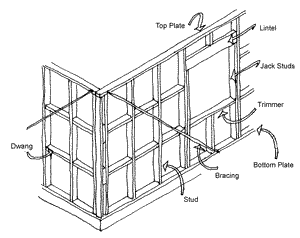Dwang

In construction, a nogging[1] or nogging piece[2] (England, Australia), dwang (Scotland,[1] South Island, New Zealand,[3]) blocking (North America), or noggin (North Island, New Zealand),.[4] They are also simply called nogs in New Zealand and Australia (No reference). They are horizontal bracing pieces used between wall studs or floor joists to give rigidity to the wall or floor frames of a building. Noggings may be made of timber, steel, or aluminium. If made of timber they are cut slightly longer than the space they fit into, and are driven into place so they fit tightly or are rebated into the wall stud.
The interval between noggings is dictated by local building codes and by the type of timber used; a typical timber-framed house in a non-cyclonic area will have two or three noggings per storey between each pair of neighbouring studs. Additional noggings may be added as grounds for later fixings.
Noggings between vertical studs generally brace the studs against buckling under load; noggings on floor joists prevent the joists from twisting or rotating under load (lateral-torsional buckling), and are often fixed at intervals, in pairs diagonally for that reason. In floors this type of bracing is also called herringbone strutting.
Noggings provide no bracing effect in shear and are generally supplemented by diagonal bracing to prevent the frame from racking.
References
- ↑ 1.0 1.1 Fleming, Eric. Construction technology: an illustrated introduction. Oxford: Blackwell, 2005. 123, 160. Print.
- ↑ Loudon, J. C.. An encyclopaedia of cottage, farm, and villa architecture and furniture: containing numerous designs for dwellings, from the cottage to the villa, including farm houses, farmeries, and other agricultural buildings, several designs for country inns, public. London: Longman, Rees, Orme, Brown, Green & Longman, 1833. 39. Print.
- ↑ "Dwang" def. 1. Cryer, Max. The Godzone dictionary of favourite New Zealand words and phrases. Auckland [N.Z.: Exisle Pub., 2006. 62. Print.
- ↑ "Nogging". Free dictionary. Retrieved 1 January 2012.